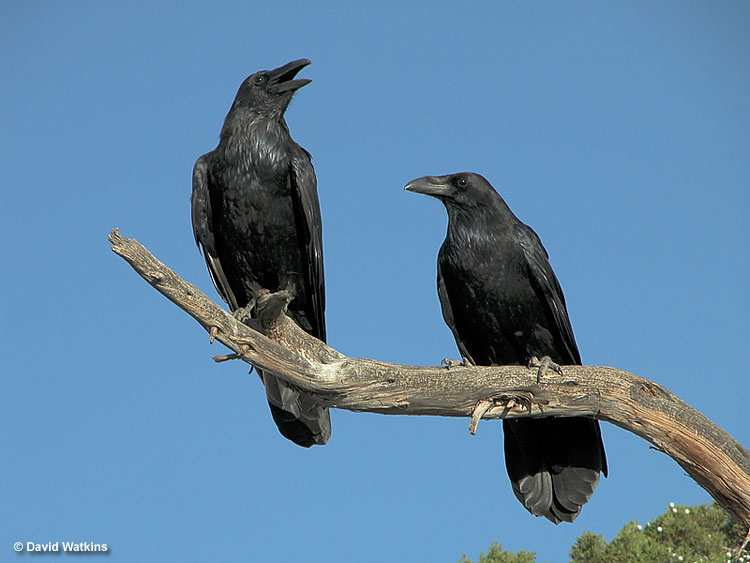The Common Raven (Corvus corax), a large, black bird is a highly adaptable and intelligent species found in diverse habitats across the Americas, Eurasia, and Africa.
These birds have a varied diet consisting of both plant and animal matter, with a particular preference for carrion and scavenging.
Read on to learn more about these intelligent and playful creatures!
On this page
Identification
Both male and female Common Ravens are massive black birds with a wedge-shaped tail, a well-developed ruff of feathers on the throat, and a distinct Bowie knife-like beak.
In flight, ravens have long, wedge-shaped tails and slender bodies with long, narrow wings and thin “fingers” at the wingtips. They are entirely black, including their legs, eyes, and beak.
Juvenile Common Ravens are quite similar to adults but have duller plumage and blue eyes.
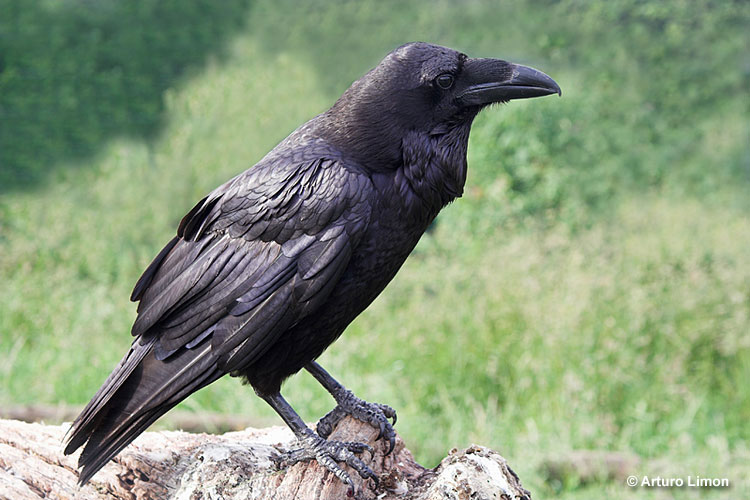
Adult ravens usually measure between 22-27 inches, weigh between 24-57 ounces, and have a wingspan of 45-47 inches.
Common Ravens are not as social as crows and are typically seen alone or in pairs, except when gathered around food sources like landfills. These confident and inquisitive birds strut around or occasionally bound forward with light, two-footed hops. In flight, they are graceful, exhibiting a range of movements including soaring, gliding, and slow flaps.
The common raven has a wide range of vocalizations, with a distinctive, deep, resonant prruk-prruk-prruk call that is unlike any other corvid.
Related: Do you know the differences between crows and ravens?
They can mimic sounds from their environment, including human speech, and make non-vocal sounds like wing whistles and bill snapping. Scientists have categorized their vocalizations into as many as 33 different categories based on sound and context.
Food
Common Raven’s diet consists of both animal and plant matter, although they’re mostly scavengers. These omnivores are highly opportunistic and the food they eat varies with location and season.
The animal part of the diet consists of small mammals, arthropods, birds and their eggs and nestlings, reptiles, amphibians, and insects, such as beetles and caterpillars. The plant part of their diet includes grains, fruits, nuts, berries, buds, and seeds.
They also feed on carrion and the insects around them and might even consume the undigested parts of animal feces. In human settlements, you can see them rummage for food in the trash and stalk around picnic areas to snatch unattended food items.
Ravens usually forage in pairs and may cooperate to catch prey. They are well-known nest raiders, but they usually forage and feed on the ground.
Nesting and Eggs
The Common Raven is a bird species known for their strong family bonds, with mated pairs traveling together. Juvenile ravens begin to court early on, but bonding may not occur until two to three years later.
During courtship, male ravens display their aerial skills, intelligence, and hunting abilities. Once paired, the birds usually nest in the same location for the rest of their lives, aggressively defending their territory and resources.
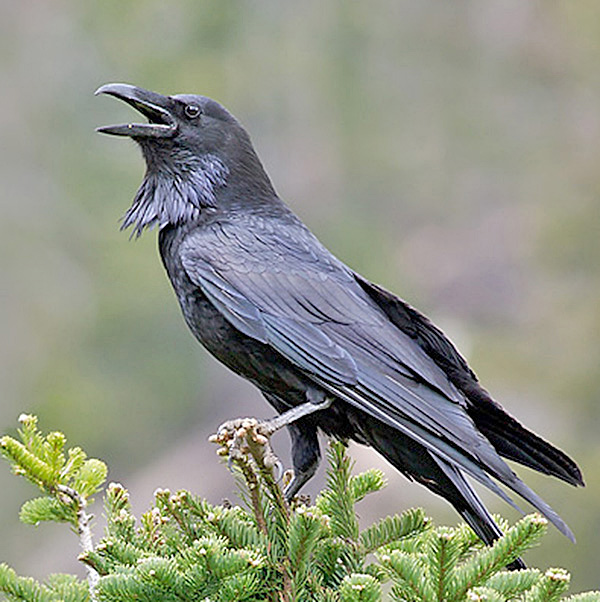
Photograph © Glenn Bartley.
The Common Raven builds a nest in the shape of a deep bowl, using large sticks and twigs, reinforces it with mud, roots, and bark, and lines the inside with softer materials such as fur.
The nest is commonly placed on a high rock cliff or in a tall tree, often using the same site year after year, with additional material added on top of the old nest. Both the male and female birds participate in nest-building.
Females lay between three and seven eggs that are pale bluish to greenish with dark blotches, and the incubation period is around 18 to 25 days, with only the female incubating the eggs and the male feeding the female.
The young birds are fed by both parents and remain with them for six months after fledging, which occurs between 28 and 50 days after hatching. Sexual maturity is reached at around three years of age.
Current Situation
Common Ravens range throughout the Holarctic. They are an adaptable species and can be found in both the Americas and Eurasia. You can meet them in Europe, Scandinavia, east through central Asia, northwestern Africa, and North and Central America.
In the Americas, they are widespread throughout most of Canada and Central America. In the United States, most of the population resides in the western part of the country.
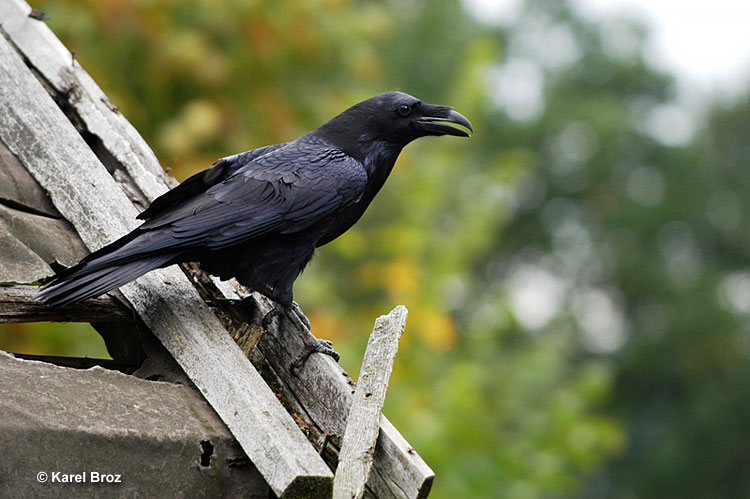
Common Raven’s habitats are diverse, but they prefer to live in wooded areas with large open land nearby. They inhabit tundra, taiga, grasslands, coniferous and deciduous forests, scrub forests, mountains, coasts, and coastal cliffs, and can also do well near human settlements, such as farms and towns.
Since these birds are very widespread, they’re listed as of least concern in the IUCN Red List. Their numbers are increasing and in some areas, they’re considered an agricultural pest since they can cause damage to different crops and harm livestock.
Facts
- Common Ravens are one of the most intelligent bird species, known to solve problems and use tools to get food. They also like to play and have been observed to slide down snowy hills, play tag with other species, and craft their own toys.
- Common Raven lifespan is usually around 10-15 years. The oldest known individual lived to be 22 years and 7 months old.
- Ravens are often associated with death and bad omens because of their black plumage and their habit of scavenging carcasses. On the other hand, they’re also considered to be messengers between the spiritual and our world and symbols of change and opportunity.
- A group of ravens is called unkindness. This comes from the belief that ravens didn’t care much about their offspring and because they’re associated with bad luck.
- You may get extremely lucky and encounter a white raven. However, white ravens are not albinos. They have a rare pigment called leucism, which gives them light cream-colored plumage and blue eyes.
Similar Species
There are only two species similar to Common Ravens. On the other hand, they are quite hard to distinguish so you should pay attention.

American Crow. Photograph © Alan D. Wilson
Similarly to ravens, American Crows are also stocky all-black birds.
However, American Crows are significantly smaller and have a short and rounded or squared tail, whereas ravens have a diamond-shaped one.
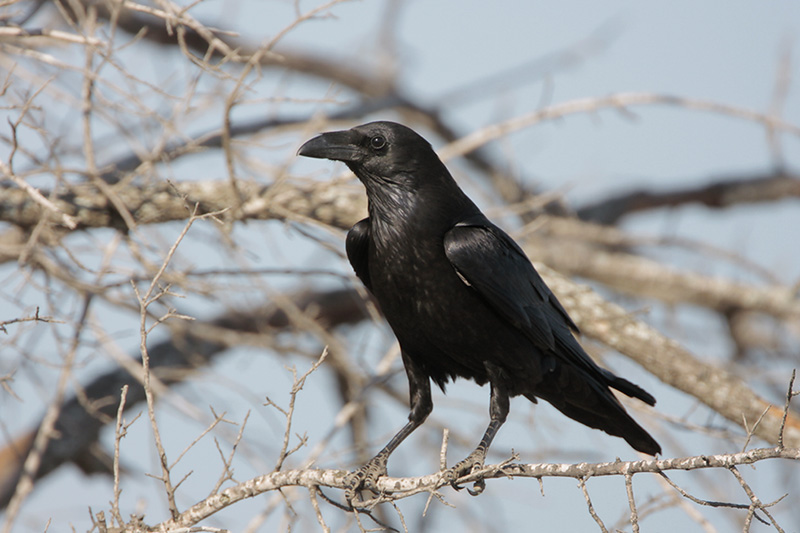
Chihuahuan Raven. Photograph © Greg Lavaty.
These two tend to be a bit harder to distinguish since they look quite the same.
Chihuahuan Ravens are smaller, have a higher-pitched call, and have white bases to the body feathers.
Chihuahuan Ravens also have a much smaller range and tend to be found in arid deserts at lower elevations.
Frequently Asked Questions
Is Common Raven a crow?
Crows and ravens are not the same, although they belong to the same genus and look very similar.
Can Common Ravens talk?
Ravens can learn to mimic human speech, learning words and phrases. However, this usually only happens in captivity.
Where do Common Ravens live?
Common Ravens live throughout the Holarctic region in forests that have large open areas nearby. They can also be found near human settlements, such as farms and towns.
What attracts ravens?
Ravens are attracted to food, such as seeds, grain, carrion, or even garbage.
Do ravens bond with humans?
Ravens can bond with humans if a human has nurtured them from birth. You can also befriend wild ravens, but it’s a bit trickier and takes time.
What does it mean when a raven visits you?
If a raven visits you, it might mean that you have a suitable living habitat or feeding ground for it. In a spiritual and symbolic sense, however, a raven visiting you might mean a spirit of a loved one is nearby or that you might need some kind of guidance in your life.

